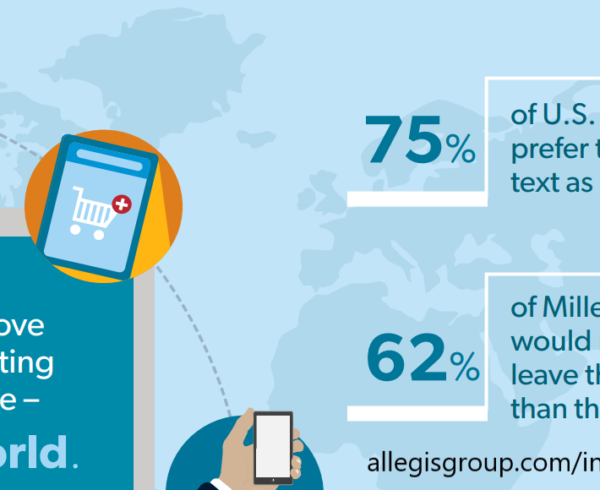The “New Traditional” Workforce
A recent Allegis Group survey found that 7.7 percent of companies were fully satisfied that their recruiting functions met expectations for quality, speed, and cost control. If you feel you’re in the other 92 percent, congratulations! You know you have work to do. But if you feel you’re part of the eight percent high-performer group, don’t get comfortable. Your organization will also have work to do — a lot of it.
In my experience helping companies transform their talent capabilities, I’ve seen first-hand how human capital is fundamentally changing right before our eyes. Consider a recent example of a pizza restaurant recruiting for five IT positions, a delivery driver, and a prep cook. Why is a single-location restaurant hiring for five IT positions and two non-technology positions? Well, the answer is simple: they haven’t fully developed driverless delivery yet. But rest assured, that’s on its way, too.
Even if your organization isn’t Apple, Google, or the world’s most advanced pizza joint, you will still feel the effects of innovation. Some roles may disappear. Some may be automated, and (in probably the biggest shift) parts of many tasks will automate, change, or disappear altogether. That means companies not only need to keep an eye on the way they secure and retain talent; they also have to begin to think about how work gets done.
So, what is a human capital decision maker to do? The lessons of the survey are clear: companies have to keep an eye on both the best practices of today and be prepared to embrace the rapid change in how work gets done.
Keeping an eye on the today’s best practices: great recruiting and talent management matters!
Regardless of what the future holds, nearly every company is experiencing a recruiting environment where competition is ratcheting up the pressure to excel. That’s where the talent leaders in the survey are pulling ahead. The companies most satisfied with their talent organizations in the survey are 67 percent more likely to rate their sourcing channels as effective. They are also 52 percent more likely to apply best practices in job definition, screening, and onboarding.
Even if you consider that these are self-rated responses, the results suggest that attention to detail does set higher-performing talent organizations apart from the crowd, and examining every aspect of recruiting can help you uncover opportunities for improvement. For example, if you haven’t re-examined your job descriptions recently, now is a good time to start doing so. It may not transform the way your company gets work done, but it will make you more competitive.
But there’s more to the story. Examining your talent acquisition processes today does more than simply improve current results. It can cause you to ask the right questions, and that is where every organization must excel: keeping an eye on the future.
Looking to the future: Will pressure on worker supply finally break traditional recruiting models?
Mastering your current processes does not preclude the need to look to more strategic levels of change occurring in the markets today. One report by Gartner predicts that more than 30 percent of technology jobs will go unfulfilled in 2020 due to a shortage of the right skills. Other studies predict a dramatic rise in the non-traditional employee population, with some estimates suggesting up to half of the workforce will consist of freelancers as soon as 2020.
One might challenge these predictions as overstated, but even if you shrink them by half, the numbers still point to real issues for organizations that don’t start thinking outside their comfort zones. The most pressing trends are no longer news. Millennials are the largest portion of the workforce, and they may not be looking for a traditional job or clear career path. Baby Boomers are retiring or semi-retiring. Automation and artificial intelligence are now taking on many tasks formerly owned by knowledge workers. These are just a few of the big picture shifts.
Then, beyond the demographics, companies realize that many traditional ways of thinking about employees no longer apply for many workers. Location may not matter. Seniority and experience may not correlate with higher pay or positions. Workers may not be advancing through a single employer but instead be moving forward through projects and accomplishments across several different companies.
For companies and their recruiting functions, these trends bring new pressures. Companies must not only master the basics of recruiting, but they will need to be able to re-think how work gets done. Instead of defining a job, an organization will need to define a need and an outcome. That outcome may be achieved through a creative use of traditional employees, machines, contractors, or freelancers. Parts of roles will disappear, and new ones may arise. People who do work for a company may work a much briefer tenure than workers in the past.
All of these pressures add up to more work for business and talent leaders. The volume of recruiting will continue to rise to keep up with shorter tenured workers. The need for planning will rise as companies take on new and varied efforts focused on innovation and growth. Increasingly, talent organizations are relying on advances in technology, outside recruiting and workforce services providers, and strategic experts to help them keep up with demand.
These new demands will weigh heavily on both the high-performing leading talent organizations and the companies in the rest of the pack. The recent Allegis Group survey report suggests that the job description represents the real step one in recruiting. This may be true today, but don’t take it for granted. The real step one begins with a look at business strategy and the work to be done. That’s where the talent leaders of the future will set themselves apart.
Nontraditional workers are now a key part of the standard workforce. The number of people engaging in independent work will continue to rise according to a recent study by The Aspen Institute. Are you prepared to augment your dwindling permanent staff with “new traditional” workers and automated technology?
Author’s Bio: Craig Fisher is Head of Marketing and Employer Brand SME at Allegis Global Solutions, an Allegis Group company. He has consulted with companies like CA Technologies, Hootsuite, Yum! Brands, LinkedIn, FOX News, and many more on sales, brand, and recruitment strategy. Connect with Craig on Twitter and Instagram @fishdogs, and on his blog at www.fishdogs.com.
This post originally appeared on the Allegis Group Blog





